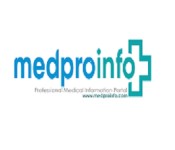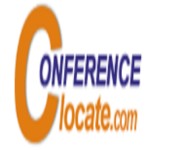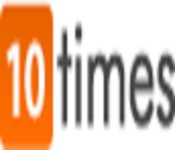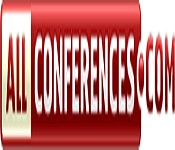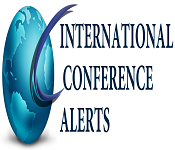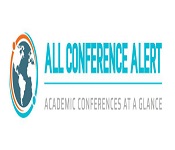
Biosensors 2023
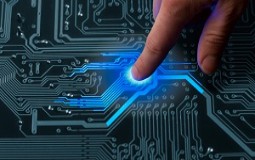
Theme: New research and innovations of Biosensors Technologies and Bioelectronics
The 8th International on Biosensors and Bioelectronics, scheduled during August 07-08, 2023 at Toronto, Canada which will allow the professionals to characteristic their exploration of work through introductions and have a probability to select up mastering about the present circumstance of Bioengineering.
In the era of quantitative biology and healthcare considerable data, Biosensors & Bioelectronics appears to be the always trending topic with today's lookup technologies. Everyone who explores to strengthen their knowledge and gain extended advanced technical cleverness is welcome to present/get new ideas. We assure our attendees return to their place with the self-belief to improve their abilities and outfitted with certified approaches to work with us.
In the era of quantitative biology and healthcare considerable data, Biosensors & Bioelectronics appears to be the always trending topic with today's lookup technologies. Everyone who explores to strengthen their knowledge and gain extended advanced technical cleverness is welcome to present/get new ideas. We assure our attendees return to their place with the self-belief to improve their abilities and outfitted with certified approaches to work with us.
Session-1: Biosensors, Bio-sensing Technologies
The biosensor is an analytical device that converts a biological response into an electrical signal. The device is made up of a transducer and a biological element that may be an enzyme, an antibody, or nucleic acid. The characteristic identifying segment can be a substance, a receptor counter pro, or DNA. The transducer, which can be optical, physicochemical, piezoelectric, or electrochemical, produces an electrical standard contrasting with the social event of the substance being evaluated. Bio-sensing technologies are of increasing importance in healthcare, agriculture-food, environmental, and security sectors, and this is reflected in the continued growth of global markets for such technologies. Biomechanics is closely related to engineering because it often uses trade.
Biosensors Conference | Bioelectronics Conference | Biosensors Congress | Call For Abstract | Biosensors Meeting | Young Researchers Forum | Registration | Sponsorship | Workshop | Exhibition
Session -2: Bioelectronics
Bioelectronics: Biological properties can be measured and altered using electronics, magnetics, photonics, sensors, circuits, and algorithms. Applications range from basic biological science to clinical medicine and enable new discoveries, diagnoses, and treatments by creating novel devices, systems, and analyses. Bioelectronics, specifically bio-molecular electronics, is described as 'the research and development of bio-inspired inorganic and organic materials and of bio-inspired hardware architectures for the implementation of new information processing systems, sensors, and actuators, and for molecular manufacturing down to the atomic scale'. The National Institute of Standards and Technology (NIST), defined bioelectronics in a report as "the discipline resulting from the convergence of biology and electronics". Bio-analysis is one of the sub-categories of Chemistry that helps in measuring Xenobiotics (unnatural concentration or location of drugs, Metabolites, and biological molecules) in a biological system.
Biosensors Conference | Bioelectronics Conference | Biosensors Congress | Call For Abstract | Biosensors Meeting | Young Researchers Forum | Registration | Sponsorship | Workshop | Exhibition
Session -3: Bio-MEMS/NEMS
Microelectromechanical systems (MEMS) have played key roles in many important areas, for example, transportation, communication, automated manufacturing, environmental monitoring, health care, defense systems, and a wide range of consumer products. MEMS are inherently small, thus offering attractive characteristics such as reduced size, weight, and power dissipation, and improved speed and precision compared to their macroscopic counterparts. Integrated Circuit (IC) fabrication technology has been the primary enabling technology for MEMS besides a few special etching, bonding, and assembly techniques. Microfabrication provides a powerful tool for batch processing and miniaturizing electromechanical devices and systems to a dimensional scale that is not accessible by conventional machining techniques. As IC fabrication technology continues to scale toward deep submicron and nanometer feature sizes, a variety of Nanoelectromechanical systems (NEMS) can be envisioned in the foreseeable future. Nanoscale mechanical devices and systems integrated with Nanoelectronics will open a vast number of new exploratory research areas in science and engineering.
Biosensors Conference | Bioelectronics Conference | Biosensors Congress | Call For Abstract | Biosensors Meeting | Young Researchers Forum | Registration | Sponsorship | Workshop | Exhibition
Session-4: Nanotechnology in Biosensors
Nanobiosensors are essentially sensors that are comprised of nanomaterials. They can play a very major role in the detecting system of biosensor innovation. Incorporated devices of the nanomaterials with electrical systems offer ascent to Nanoelectromechanical Systems (NEMS), which are extremely dynamic in their electrical transduction instruments. The nanotechnology-based biosensor or nano biosensor headway is changing the prosperity mind industry, for example, the nano biosensor advancement is utilized as a piece of the estimation of metabolites, checking of diabetes, and so on authentic medicine, country security. The utilization of nanomaterials for the improvement of biosensors has redesigned their affectability and execution of them and has permitted the presentation of different new pennant transduction propels in biosensors. Biosensors frequently comprise a biological recognition molecule immobilized onto the surface of a signal transducer to give a solid state analytical device. The use of nanomaterials has acknowledged the establishment of many new signal transduction technologies in biosensors through nanotechnology.
Biosensors Conference | Bioelectronics Conference | Biosensors Congress | Call For Abstract | Biosensors Meeting | Young Researchers Forum | Registration | Sponsorship | Workshop | Exhibition
Session-5: Microfluidics- Technology & Healthcare
Microfluidics will be one of the key components of the current technological revolution in the biotech sphere, and it might accelerate some of the research on the aging process. Lab-on-a-chip technology has started to conquer biological and medical labs. Nanofluidics is drawing researchers' attention because it has unique liquid and fluidic properties that are not observed in any other technology. All these fields have advanced rapidly over the past 20 years and developed into cutting-edge technologies that have great application potential ranging from biology to electronics, from tissue engineering to organ-on-a-chip, from fertility enhancement to mutation diagnostics, from DNA sequencing to DNA modification, from continuous to digital microfluidics, from developing to the developed world. Nanomedicine is the medical application of nanotechnology for the treatment and prevention of major ailments, including cancer and cardiovascular diseases.
Biosensors Conference | Bioelectronics Conference | Biosensors Congress | Call For Abstract | Biosensors Meeting | Young Researchers Forum | Registration | Sponsorship | Workshop | Exhibition
The biosensor is an analytical device that converts a biological response into an electrical signal. The device is made up of a transducer and a biological element that may be an enzyme, an antibody, or nucleic acid. The characteristic identifying segment can be a substance, a receptor counter pro, or DNA. The transducer, which can be optical, physicochemical, piezoelectric, or electrochemical, produces an electrical standard contrasting with the social event of the substance being evaluated. Bio-sensing technologies are of increasing importance in healthcare, agriculture-food, environmental, and security sectors, and this is reflected in the continued growth of global markets for such technologies. Biomechanics is closely related to engineering because it often uses trade.
Biosensors Conference | Bioelectronics Conference | Biosensors Congress | Call For Abstract | Biosensors Meeting | Young Researchers Forum | Registration | Sponsorship | Workshop | Exhibition
Session -2: Bioelectronics
Bioelectronics: Biological properties can be measured and altered using electronics, magnetics, photonics, sensors, circuits, and algorithms. Applications range from basic biological science to clinical medicine and enable new discoveries, diagnoses, and treatments by creating novel devices, systems, and analyses. Bioelectronics, specifically bio-molecular electronics, is described as 'the research and development of bio-inspired inorganic and organic materials and of bio-inspired hardware architectures for the implementation of new information processing systems, sensors, and actuators, and for molecular manufacturing down to the atomic scale'. The National Institute of Standards and Technology (NIST), defined bioelectronics in a report as "the discipline resulting from the convergence of biology and electronics". Bio-analysis is one of the sub-categories of Chemistry that helps in measuring Xenobiotics (unnatural concentration or location of drugs, Metabolites, and biological molecules) in a biological system.
Biosensors Conference | Bioelectronics Conference | Biosensors Congress | Call For Abstract | Biosensors Meeting | Young Researchers Forum | Registration | Sponsorship | Workshop | Exhibition
Session -3: Bio-MEMS/NEMS
Microelectromechanical systems (MEMS) have played key roles in many important areas, for example, transportation, communication, automated manufacturing, environmental monitoring, health care, defense systems, and a wide range of consumer products. MEMS are inherently small, thus offering attractive characteristics such as reduced size, weight, and power dissipation, and improved speed and precision compared to their macroscopic counterparts. Integrated Circuit (IC) fabrication technology has been the primary enabling technology for MEMS besides a few special etching, bonding, and assembly techniques. Microfabrication provides a powerful tool for batch processing and miniaturizing electromechanical devices and systems to a dimensional scale that is not accessible by conventional machining techniques. As IC fabrication technology continues to scale toward deep submicron and nanometer feature sizes, a variety of Nanoelectromechanical systems (NEMS) can be envisioned in the foreseeable future. Nanoscale mechanical devices and systems integrated with Nanoelectronics will open a vast number of new exploratory research areas in science and engineering.
Biosensors Conference | Bioelectronics Conference | Biosensors Congress | Call For Abstract | Biosensors Meeting | Young Researchers Forum | Registration | Sponsorship | Workshop | Exhibition
Session-4: Nanotechnology in Biosensors
Nanobiosensors are essentially sensors that are comprised of nanomaterials. They can play a very major role in the detecting system of biosensor innovation. Incorporated devices of the nanomaterials with electrical systems offer ascent to Nanoelectromechanical Systems (NEMS), which are extremely dynamic in their electrical transduction instruments. The nanotechnology-based biosensor or nano biosensor headway is changing the prosperity mind industry, for example, the nano biosensor advancement is utilized as a piece of the estimation of metabolites, checking of diabetes, and so on authentic medicine, country security. The utilization of nanomaterials for the improvement of biosensors has redesigned their affectability and execution of them and has permitted the presentation of different new pennant transduction propels in biosensors. Biosensors frequently comprise a biological recognition molecule immobilized onto the surface of a signal transducer to give a solid state analytical device. The use of nanomaterials has acknowledged the establishment of many new signal transduction technologies in biosensors through nanotechnology.
Biosensors Conference | Bioelectronics Conference | Biosensors Congress | Call For Abstract | Biosensors Meeting | Young Researchers Forum | Registration | Sponsorship | Workshop | Exhibition
Session-5: Microfluidics- Technology & Healthcare
Microfluidics will be one of the key components of the current technological revolution in the biotech sphere, and it might accelerate some of the research on the aging process. Lab-on-a-chip technology has started to conquer biological and medical labs. Nanofluidics is drawing researchers' attention because it has unique liquid and fluidic properties that are not observed in any other technology. All these fields have advanced rapidly over the past 20 years and developed into cutting-edge technologies that have great application potential ranging from biology to electronics, from tissue engineering to organ-on-a-chip, from fertility enhancement to mutation diagnostics, from DNA sequencing to DNA modification, from continuous to digital microfluidics, from developing to the developed world. Nanomedicine is the medical application of nanotechnology for the treatment and prevention of major ailments, including cancer and cardiovascular diseases.
Biosensors Conference | Bioelectronics Conference | Biosensors Congress | Call For Abstract | Biosensors Meeting | Young Researchers Forum | Registration | Sponsorship | Workshop | Exhibition
Session-6: Bioinstrumentation
Bioinstrumentation is the development of technologies for the measurement and manipulation of parameters within biological systems, focusing on the application of engineering tools for scientific discovery and for the diagnosis and treatment of disease. Bioinstrumentation is a part of Biomedical engineering application of engineering principles and design concepts to medicine and biology for healthcare purposes (e.g. diagnostic or therapeutic).
Bioinstrumentation refers to high-tech, often costly instrumentation used to conduct cutting-edge research in the biological sciences. Biological research has been revolutionized in the last 15-20 years, these advances have provided the capacity to increase the scope and throughout of research activities. This expansion in scope has resulted in the development of new fields of study. Advances in instrumentation for techniques such as DNA sequencing and quantitative PCR, microarray analysis, and mass spectrometry now allow scientists to simultaneously study all of the genes and proteins of an organism, and have resulted in the new fields of genomics and proteomics.
Biosensors Conference | Bioelectronics Conference | Biosensors Congress | Call For Abstract | Biosensors Meeting | Young Researchers Forum | Registration | Sponsorship | Workshop | Exhibition
Bioinstrumentation is the development of technologies for the measurement and manipulation of parameters within biological systems, focusing on the application of engineering tools for scientific discovery and for the diagnosis and treatment of disease. Bioinstrumentation is a part of Biomedical engineering application of engineering principles and design concepts to medicine and biology for healthcare purposes (e.g. diagnostic or therapeutic).
Bioinstrumentation refers to high-tech, often costly instrumentation used to conduct cutting-edge research in the biological sciences. Biological research has been revolutionized in the last 15-20 years, these advances have provided the capacity to increase the scope and throughout of research activities. This expansion in scope has resulted in the development of new fields of study. Advances in instrumentation for techniques such as DNA sequencing and quantitative PCR, microarray analysis, and mass spectrometry now allow scientists to simultaneously study all of the genes and proteins of an organism, and have resulted in the new fields of genomics and proteomics.
Biosensors Conference | Bioelectronics Conference | Biosensors Congress | Call For Abstract | Biosensors Meeting | Young Researchers Forum | Registration | Sponsorship | Workshop | Exhibition
Session-7: Optical Biosensors
Optical biosensors are a powerful alternative to conventional analytical techniques, for their particularly high specification, sensitivity, small size, and cost-effectiveness. Although promising developments of optical biosensors are being reported, there are not many reports on applications of optical biosensors in the practical field. The research and technological development of optical biosensors have experienced exponential growth during the last decade because this technology has a great potential for the direct, real-time, and label-free detection of many chemical and biological substances. The success of the biosensor technology can be deduced for the increasing number of commercially available instruments. A highly multidisciplinary approach including microelectronics, MEMS, micro/nanotechnologies, molecular biology, nano-biotechnology, and chemistry is needed for the implementation of such new analytical devices.
Biosensors Conference | Bioelectronics Conference | Biosensors Congress | Call For Abstract | Biosensors Meeting | Young Researchers Forum | Registration | Sponsorship | Workshop | Exhibition
Optical biosensors are a powerful alternative to conventional analytical techniques, for their particularly high specification, sensitivity, small size, and cost-effectiveness. Although promising developments of optical biosensors are being reported, there are not many reports on applications of optical biosensors in the practical field. The research and technological development of optical biosensors have experienced exponential growth during the last decade because this technology has a great potential for the direct, real-time, and label-free detection of many chemical and biological substances. The success of the biosensor technology can be deduced for the increasing number of commercially available instruments. A highly multidisciplinary approach including microelectronics, MEMS, micro/nanotechnologies, molecular biology, nano-biotechnology, and chemistry is needed for the implementation of such new analytical devices.
Biosensors Conference | Bioelectronics Conference | Biosensors Congress | Call For Abstract | Biosensors Meeting | Young Researchers Forum | Registration | Sponsorship | Workshop | Exhibition
Session-8: Biosensors for Environmental Monitoring
Biosensors are of great importance because of their several advantages over the conventional techniques in the field of analysis. Biosensors are researched and applied in several diverse areas, such as health, medicine, defense, agriculture and food safety, industry and environmental monitoring, etc.
Biosensors can be classified according to their transduction principle such as optical, electrochemical, and piezoelectric based on their recognition element as immunosensors, aptasensors, genosensors, and enzymatic biosensors, when antibodies, aptamers, nucleic acids, and enzymes are, respectively, used.|
The research on the construction of biosensors for environmental monitoring of organic pollutants, potentially toxic elements, and pathogens has been contributed to the sustainable development of society due to the problems of environmental pollution for human health.
Biosensors Conference | Bioelectronics Conference | Biosensors Congress | Call For Abstract | Biosensors Meeting | Young Researchers Forum | Registration | Sponsorship | Workshop | Exhibition
Biosensors are of great importance because of their several advantages over the conventional techniques in the field of analysis. Biosensors are researched and applied in several diverse areas, such as health, medicine, defense, agriculture and food safety, industry and environmental monitoring, etc.
Biosensors can be classified according to their transduction principle such as optical, electrochemical, and piezoelectric based on their recognition element as immunosensors, aptasensors, genosensors, and enzymatic biosensors, when antibodies, aptamers, nucleic acids, and enzymes are, respectively, used.|
The research on the construction of biosensors for environmental monitoring of organic pollutants, potentially toxic elements, and pathogens has been contributed to the sustainable development of society due to the problems of environmental pollution for human health.
Biosensors Conference | Bioelectronics Conference | Biosensors Congress | Call For Abstract | Biosensors Meeting | Young Researchers Forum | Registration | Sponsorship | Workshop | Exhibition
Session-9: Biosensors in Drug Discovery
Biosensors are, by definition, sensing devices comprising a biological component (enzyme, antibody, animal or plant cell, oligonucleotide, lipid, microorganisms, etc.) intimately connected to a physical transducer (electrode, optical fiber, vibrating quartz, etc.). This dual configuration permits a quantitative study of the interaction between a drug compound and an immobilized biocomponent. Enzyme-based biosensors can be applied in the pharmaceutical industry for monitoring chemical parameters in the production process (in bioreactors). Affinity biosensors are suitable for high-throughput screening of bioprocess-produced antibodies and for candidate drug screening. They are suitable for selective and sensitive immunoassays in clinical laboratories and for decentralized detection of drug residues. Enzyme-based biosensors may be used in hospitals for bedside drug testing, emergency control, inpatient treatment control (anticancer therapy), etc. Current research efforts are focused on proteins, tissues, or living cells immobilized in microfabricated configurations for high-throughput drug screening and discovery.
Biosensors Conference | Bioelectronics Conference | Biosensors Congress | Call For Abstract | Biosensors Meeting | Young Researchers Forum | Registration | Sponsorship | Workshop | Exhibition
Biosensors are, by definition, sensing devices comprising a biological component (enzyme, antibody, animal or plant cell, oligonucleotide, lipid, microorganisms, etc.) intimately connected to a physical transducer (electrode, optical fiber, vibrating quartz, etc.). This dual configuration permits a quantitative study of the interaction between a drug compound and an immobilized biocomponent. Enzyme-based biosensors can be applied in the pharmaceutical industry for monitoring chemical parameters in the production process (in bioreactors). Affinity biosensors are suitable for high-throughput screening of bioprocess-produced antibodies and for candidate drug screening. They are suitable for selective and sensitive immunoassays in clinical laboratories and for decentralized detection of drug residues. Enzyme-based biosensors may be used in hospitals for bedside drug testing, emergency control, inpatient treatment control (anticancer therapy), etc. Current research efforts are focused on proteins, tissues, or living cells immobilized in microfabricated configurations for high-throughput drug screening and discovery.
Biosensors Conference | Bioelectronics Conference | Biosensors Congress | Call For Abstract | Biosensors Meeting | Young Researchers Forum | Registration | Sponsorship | Workshop | Exhibition
Session-10: Biomedical Engineering
Soft, biocompatible, resorbable, flexible, minimally invasive, durable, battery-less, and enabling wireless data transfer; are just a few of the key requirements for state-of-the-art bioelectronic devices for implantation in the body. Sensors and electrodes that mechanically behave like the tissue they are embedded into cause less tissue damage, make better tissue/device interfaces, and trigger weaker immune responses.
Drug delivery systems are bringing about technologies for the targeted drug delivery and measured issue of therapeutic agents. Drugs have long been used to improve fitness and extend lives. Biomedical engineers have given consideration to our understanding of the biological barriers to effective drug delivery, such as transport in the circulatory system and drug movement through cells and tissues.
Biosensors Conference | Bioelectronics Conference | Biosensors Congress | Call For Abstract | Biosensors Meeting | Young Researchers Forum | Registration | Sponsorship | Workshop | Exhibition
Soft, biocompatible, resorbable, flexible, minimally invasive, durable, battery-less, and enabling wireless data transfer; are just a few of the key requirements for state-of-the-art bioelectronic devices for implantation in the body. Sensors and electrodes that mechanically behave like the tissue they are embedded into cause less tissue damage, make better tissue/device interfaces, and trigger weaker immune responses.
Drug delivery systems are bringing about technologies for the targeted drug delivery and measured issue of therapeutic agents. Drugs have long been used to improve fitness and extend lives. Biomedical engineers have given consideration to our understanding of the biological barriers to effective drug delivery, such as transport in the circulatory system and drug movement through cells and tissues.
Biosensors Conference | Bioelectronics Conference | Biosensors Congress | Call For Abstract | Biosensors Meeting | Young Researchers Forum | Registration | Sponsorship | Workshop | Exhibition
Bioelectronics and Biosensors Market size was valued at US$ 27.17 Bn. in 2021 and the total revenue is expected to grow at a CAGR of 9.2% through 2022 to 2027, reaching nearly US$ 46.07 Bn.
Bioelectronics and Biosensors Market Overview:
Electrocardiographs, cardiac pacemakers and defibrillators, blood pressure and flow monitors, and medical imaging systems are all examples of bioelectronics in use. During quality control operations in the food sector, biosensors are used to measure carbohydrates, alcohol, and acids, for example. The gadgets can also be used to monitor fermentation in beer, yoghurt, and soft drinks production. Rapid detection, accuracy, ease of operation, a short response time, and low cost, high sensitivity, and reliability are all requirements for biosensors used in measurement. Based on the type of transducer, biosensors can be divided into electrochemical, optical, piezoelectric, and thermal sensors.

Bioelectronics and Biosensors Market Dynamics:
During the forecast period, the rising prevalence of chronic diseases such as heart disease and cancer is expected to drive demand for biosensors around the world. This market is expected to develop because of the higher precision provided by these bioelectronics products when compared to standard diagnostics equipment. During the forecast period, rising awareness of bioelectronics and its applications in implantable devices, biochips, fabrication templates, prosthetics, artificial/bionic organs, biofuel cells, molecular motors, and electrical pills is expected to boost market growth. The continual advancements in semiconductor technology, together with developments in surface chemistry and their application to life sciences research, are the overarching technical drivers for bioelectronics. Much of the research in the subject of bioelectronics has concentrated on improving biosensors by combining biomolecules with semiconductors. Moore's law asserts that the number of features in a given area of substrate doubles every 18–24 months, indicating that semiconductor technology has grown at an exponential rate for decades. Moore's law states that with each generation of technology, computing power and capabilities improve as the cost per function lowers. The number of semiconductor applications in the life sciences has increased as Moore's law has developed. Surface chemistries that can be utilised to attach biological molecules to semiconductor substrates, in particular, have received a lot of attention. Biosensors with enzymes covalently attached to electrode surfaces and DNA recognition using surface-bound DNA functionalized polypyrrole molecules are two examples. Despite breakthroughs in the binding of biological molecules to substrates, no completely biomimetic synthetic surfaces have yet to be developed (e.g., for use in implants). Here are some technical areas or prospects that will have an impact on bioelectronics: For Systems Biology, Real-Time and Massively Parallel Molecular and Cellular Characterization The new field of systems biology, which use systems engineering methods to study cellular function, is pushing the development of new technology that can track numerous aspects of cellular behaviour over a long period of time. Systems biology represents a new way of looking at biological systems, and the knowledge gained from its methods could lead to advancements in medicine and security. However, large resources are required to build tools, as well as accompanying standards and metrology that can characterise and continually monitor cell states at sub-cellular resolutions. This demand is being addressed by advances in micro- and Nano fluidic devices that can monitor many cell populations in simultaneously. Fabrication and biologically-based sensors Cells and their components can be employed as biological transducers for measurements or as components in the creation of new materials or circuits, which is another driving factor behind bioelectronics. In other words, cell components have been exploited for purposes other than those for which they were designed. Many environmental stimuli are detectable by cells. Identifying a cell's response to a known toxin, for example, could enable it to be utilised as a "canary in a coal mine" for detecting harmful compounds in acquired air samples. Biomolecules, particularly antibodies, can act as transducers because of their high specificity for complementary molecules. By combining antibodies with new Nano-scale technology, ultra-sensitive detection methods could be developed. Bio-inspired manufacturing holds promise for building Nano scale assemblies, potentially paving the way for significant breakthroughs in sensor design and materials technology.
During the forecast period, the rising prevalence of chronic diseases such as heart disease and cancer is expected to drive demand for biosensors around the world. This market is expected to develop because of the higher precision provided by these bioelectronics products when compared to standard diagnostics equipment. During the forecast period, rising awareness of bioelectronics and its applications in implantable devices, biochips, fabrication templates, prosthetics, artificial/bionic organs, biofuel cells, molecular motors, and electrical pills is expected to boost market growth. The continual advancements in semiconductor technology, together with developments in surface chemistry and their application to life sciences research, are the overarching technical drivers for bioelectronics. Much of the research in the subject of bioelectronics has concentrated on improving biosensors by combining biomolecules with semiconductors. Moore's law asserts that the number of features in a given area of substrate doubles every 18–24 months, indicating that semiconductor technology has grown at an exponential rate for decades. Moore's law states that with each generation of technology, computing power and capabilities improve as the cost per function lowers. The number of semiconductor applications in the life sciences has increased as Moore's law has developed. Surface chemistries that can be utilised to attach biological molecules to semiconductor substrates, in particular, have received a lot of attention. Biosensors with enzymes covalently attached to electrode surfaces and DNA recognition using surface-bound DNA functionalized polypyrrole molecules are two examples. Despite breakthroughs in the binding of biological molecules to substrates, no completely biomimetic synthetic surfaces have yet to be developed (e.g., for use in implants). Here are some technical areas or prospects that will have an impact on bioelectronics: For Systems Biology, Real-Time and Massively Parallel Molecular and Cellular Characterization The new field of systems biology, which use systems engineering methods to study cellular function, is pushing the development of new technology that can track numerous aspects of cellular behaviour over a long period of time. Systems biology represents a new way of looking at biological systems, and the knowledge gained from its methods could lead to advancements in medicine and security. However, large resources are required to build tools, as well as accompanying standards and metrology that can characterise and continually monitor cell states at sub-cellular resolutions. This demand is being addressed by advances in micro- and Nano fluidic devices that can monitor many cell populations in simultaneously. Fabrication and biologically-based sensors Cells and their components can be employed as biological transducers for measurements or as components in the creation of new materials or circuits, which is another driving factor behind bioelectronics. In other words, cell components have been exploited for purposes other than those for which they were designed. Many environmental stimuli are detectable by cells. Identifying a cell's response to a known toxin, for example, could enable it to be utilised as a "canary in a coal mine" for detecting harmful compounds in acquired air samples. Biomolecules, particularly antibodies, can act as transducers because of their high specificity for complementary molecules. By combining antibodies with new Nano-scale technology, ultra-sensitive detection methods could be developed. Bio-inspired manufacturing holds promise for building Nano scale assemblies, potentially paving the way for significant breakthroughs in sensor design and materials technology.
Bioelectronics and Biosensors Market Segment Analysis:
Based on the Product, the market is segmented into Electrochemical Biosensors, Piezoelectric Biosensors, Thermal Biosensors, and Optical Biosensors. Electrochemical Biosensors segment is expected to grow rapidly at a CAGR of xx% during the forecast period 2022-2027. Electrochemical biosensors based on cells have made significant contributions to biology, medicine, chemistry, pharmacology, and environmental science. These biosensors, which use electrochemical transducers and entire cells as recognition elements, open up new possibilities for bio sensing and life science research. High sensitivity, remarkable precision and accuracy, ease of handling, low cost, little sample demand, simple integration into portable platforms, low power consumption, and multiplexing possibilities are just a few of the advantages of electrochemical biosensors.
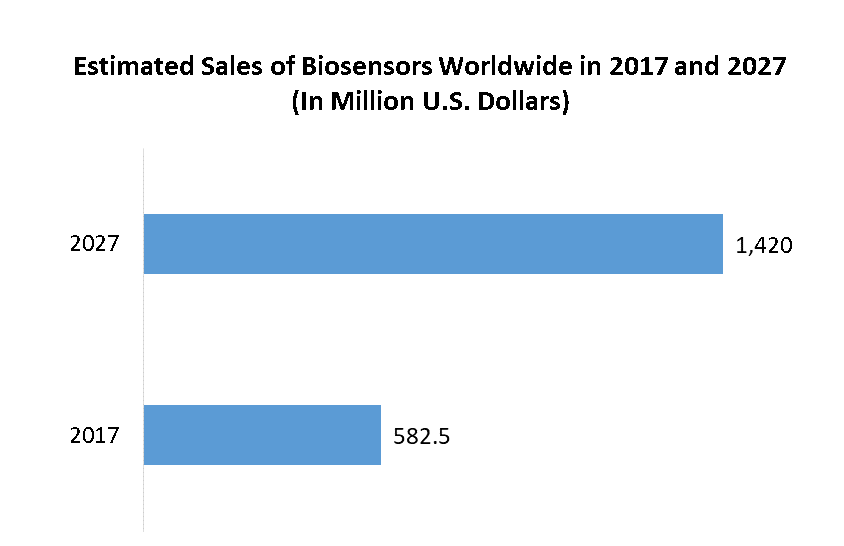
Based on the Product, the market is segmented into Electrochemical Biosensors, Piezoelectric Biosensors, Thermal Biosensors, and Optical Biosensors. Electrochemical Biosensors segment is expected to grow rapidly at a CAGR of xx% during the forecast period 2022-2027. Electrochemical biosensors based on cells have made significant contributions to biology, medicine, chemistry, pharmacology, and environmental science. These biosensors, which use electrochemical transducers and entire cells as recognition elements, open up new possibilities for bio sensing and life science research. High sensitivity, remarkable precision and accuracy, ease of handling, low cost, little sample demand, simple integration into portable platforms, low power consumption, and multiplexing possibilities are just a few of the advantages of electrochemical biosensors.

Bioelectronics and Biosensors Market Regional Insights:
Europe region is expected to dominate the Bioelectronics and Biosensors market during the forecast period 2022-2027. Europe region is expected to hold the largest market share of xx% by 2027. Since several years, Europe has been a key centre for bioelectronics and other electronic devices. This region is expected to hold a significant market share during the forecast period due to the presence of major industry participants as well as early adoption and development of bioelectronics. North America region is expected to grow rapidly at a CAGR of xx% during the forecast period 2022-2027. This is due to the growing demand for bioelectronics and biosensors in the Healthcare, Food & Beverage, and Environmental industries in the North America region.
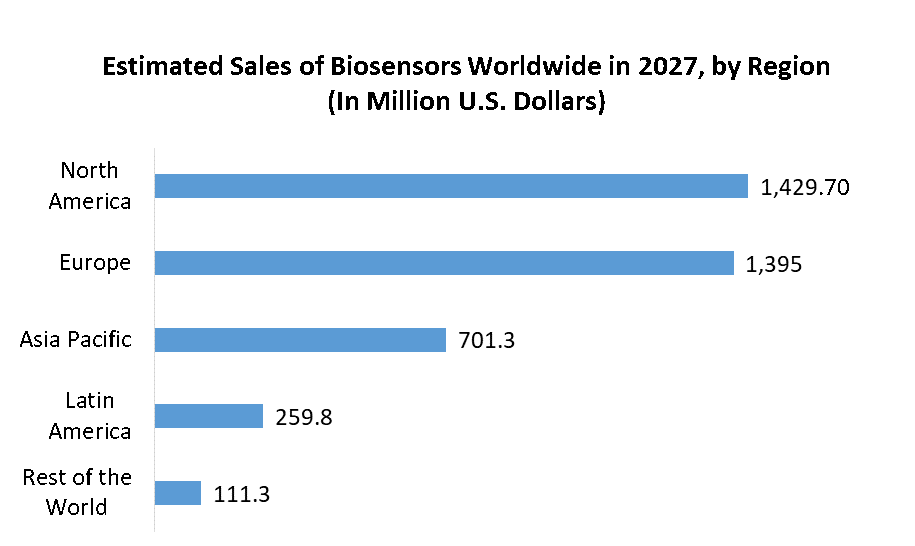
Europe region is expected to dominate the Bioelectronics and Biosensors market during the forecast period 2022-2027. Europe region is expected to hold the largest market share of xx% by 2027. Since several years, Europe has been a key centre for bioelectronics and other electronic devices. This region is expected to hold a significant market share during the forecast period due to the presence of major industry participants as well as early adoption and development of bioelectronics. North America region is expected to grow rapidly at a CAGR of xx% during the forecast period 2022-2027. This is due to the growing demand for bioelectronics and biosensors in the Healthcare, Food & Beverage, and Environmental industries in the North America region.

The objective of the report is to present a comprehensive analysis of the Global Bioelectronics and Biosensors Market to the stakeholders in the industry. The past and current status of the industry with the forecasted market size and trends are presented in the report with the analysis of complicated data in simple language. The report covers all the aspects of the industry with a dedicated study of key players that include market leaders, followers, and new entrants. PORTER, PESTEL analysis with the potential impact of micro-economic factors of the market has been presented in the report. External as well as internal factors that are supposed to affect the business positively or negatively have been analyzed, which will give a clear futuristic view of the industry to the decision-makers. The reports also help in understanding the Global Bioelectronics and Biosensors Market dynamic, structure by analyzing the market segments and project the Global Bioelectronics and Biosensors Market size. Clear representation of competitive analysis of key players by Product, price, financial position, product portfolio, growth strategies, and regional presence in the Global Bioelectronics and Biosensors Market make the report investor’s guide.
Meetings International is announcing the Young Scientist Awards through the 8th International on Biosensors and Bioelectronics which is scheduled during on August 07-08, 2023 in Toronto, Canada. This Biosensors 2023 mainly focuses on “New Research and Innovations of Biosensors Technologies and Bioelectronics".
Biosensors 2023 and upcoming online conferences will recognize participants who have significantly added value to the scientific community of Biosensors Conference and provide them with outstanding Young Scientist Awards. The Young Scientist Award will provide a strong professional development opportunity for young researchers by meeting experts to exchange and share their experiences at our international conferences.
Biosensors 2023 focuses mainly on Biosensors, Bio-sensing Technologies, Bio-electronics, Bio-MEMS/NEMS, Nanotechnology in Biosensors, Microfluidics- Technology & Healthcare, Bioinstrumentation, Optical Biosensors, Biosensors for Environmental Monitoring, Biosensors in Drug Discovery, and Biomedical Engineering. Biosensors 2023 is providing a platform for all the budding young researchers, young investigators, post-graduate/Master students, Ph.D. students, and trainees to showcase their research and innovation.
Eligibility:
Young Scientists, faculty members, post-doctoral fellows, Ph.D. scholars, and bright Final Year MSc and M.Phil. candidates. Persons from Scientific Industry can also participate.
Benefits: The Young Scientist Feature is a platform to promote young researchers in their respective areas by giving them a chance to present their achievements and future perspectives.
Biosensors 2023 and upcoming online conferences will recognize participants who have significantly added value to the scientific community of Biosensors Conference and provide them with outstanding Young Scientist Awards. The Young Scientist Award will provide a strong professional development opportunity for young researchers by meeting experts to exchange and share their experiences at our international conferences.
Biosensors 2023 focuses mainly on Biosensors, Bio-sensing Technologies, Bio-electronics, Bio-MEMS/NEMS, Nanotechnology in Biosensors, Microfluidics- Technology & Healthcare, Bioinstrumentation, Optical Biosensors, Biosensors for Environmental Monitoring, Biosensors in Drug Discovery, and Biomedical Engineering. Biosensors 2023 is providing a platform for all the budding young researchers, young investigators, post-graduate/Master students, Ph.D. students, and trainees to showcase their research and innovation.
Eligibility:
Young Scientists, faculty members, post-doctoral fellows, Ph.D. scholars, and bright Final Year MSc and M.Phil. candidates. Persons from Scientific Industry can also participate.
Benefits: The Young Scientist Feature is a platform to promote young researchers in their respective areas by giving them a chance to present their achievements and future perspectives.
-
Acknowledgment as YRF Awardee
-
Promotion on the conference website, Young Researcher Awards, and certificates
-
Link on the conference website
-
Recognition on Meetings Int. Award Page
-
Chances to coordinate with partners around the world
-
Research work can be published in the relevant journal without any publication fee
Criteria:
-
All presented abstracts will automatically be considered for the Award.
-
All the presentations will be evaluated in the conference venue
-
All the awards will be selected by the judges of the award category
-
The winners of the Young Scientist Award will receive an award certificate.
-
The awards will be assessed as far as plan and format, intelligence, argumentation and approach, familiarity with past work, engaging quality, message and primary concerns, parity of content visuals, and by and large impression.
Guidelines:
-
All submissions must be in English.
-
The topic must fit into the scientific sessions of the conference
-
Each individual participant is allowed to submit a maximum of 2 papers
-
An abstract must be submitted online as per the given abstract template
-
Abstracts must be written in Times New Roman and the font size will be 12
-
The abstract must contain a title, name, affiliation, country, speakers biography, recent photograph, image, and reference
Conditions of Acceptance:
To receive the award, the awardees must submit the presentation for which the award is given, for publication on the website, along with the author's permission. Failure to submit the PPT and permission within the designated timeframe will result in the forfeiture of the award.
Award Announcements:
The official announcement of the recipients will occur after the completion of the Biosensors 2023
To receive the award, the awardees must submit the presentation for which the award is given, for publication on the website, along with the author's permission. Failure to submit the PPT and permission within the designated timeframe will result in the forfeiture of the award.
Award Announcements:
The official announcement of the recipients will occur after the completion of the Biosensors 2023
Meetings International has taken the initiative to felicitate attendees with awards to recognize, celebrate and encourage achievement in its various conferences and events. We salute and acknowledge attainment within an industry that is continuously evolving and re-drawing the boundaries of best practices. These awards represent the pinnacle of professional achievement for event professionals. To win an award you will have been endorsed by our illustrious panel of the foremost industry professionals which is a sure-fire signifier of your formidable credentials.
Outstanding Speaker in Biosensors Conference 2023: This award recognizes academic and business speakers for their excellent presentation skills and for the significant contribution in Biosensors Conference and Bioelectronics that they make to their professions, their teams, and their patients through their practice, leadership or research endeavor. The recipient of this award will be chosen by the session chair and co-chair. The awardees will be felicitated after the completion of the oral session. Our Biosensors Conference encourages researchers from across the globe to take part as a speaker at these prestigious events.
Best Key Note Speaker in Biosensors Conference 2023: This award recognizes the notable presentations given during the course of the Biosensors Conference. It also recognizes the enthusiasm and determination of the speaker to improve the experience of all who they come into contact with. The award will be given based on the impact of the presentation on the attendees of the event. We will also be taking into account the references taken from the citations of the keynote speaker. These awardees will be felicitated by one of the members of the organizing panel present during the conference.
Best Organising Committee Member in Biosensors Conference 2023: This award seeks to recognize the continuous support provided by the Organising Committee Member of the conference. The recipient of this award will be selected by the operating committee of the Biosensors Conference 2023. The award will be given based on the support and cooperation provided by a member of the organizing panel from the beginning to the successful completion of the conference.
Outstanding Masters/Ph.D./Postdoc Thesis work presentation in Biosensors Conference 2023: This award seeks to recognize the young brains of the current era. The recipient of this award will be selected by the judge of the Young Researchers Forum. This award will be given based on the presentation skills, impact of research, and its applications for the Biosensors Conference field. Participants pursuing Master, Ph.D., or Post-Doctoral studies are eligible for this award. The awardees will be felicitated after the completion of all the oral presentations delivered under the Young Researchers Forum category.
Best Poster Award in Biosensors Conference 2023: This award recognizes the best poster presentation given during the course of an event. The recipient of this award will be selected by the judge of the poster session. An award-winning poster will be evaluated on presentation content and clarity, innovativeness of approach, communication criteria, and scientific aspects. It will also be based on layout, Biosensors, and analysis, and results description. The awardees will be felicitated after the completion of the poster session.
Outstanding Speaker in Biosensors Conference 2023: This award recognizes academic and business speakers for their excellent presentation skills and for the significant contribution in Biosensors Conference and Bioelectronics that they make to their professions, their teams, and their patients through their practice, leadership or research endeavor. The recipient of this award will be chosen by the session chair and co-chair. The awardees will be felicitated after the completion of the oral session. Our Biosensors Conference encourages researchers from across the globe to take part as a speaker at these prestigious events.
Best Key Note Speaker in Biosensors Conference 2023: This award recognizes the notable presentations given during the course of the Biosensors Conference. It also recognizes the enthusiasm and determination of the speaker to improve the experience of all who they come into contact with. The award will be given based on the impact of the presentation on the attendees of the event. We will also be taking into account the references taken from the citations of the keynote speaker. These awardees will be felicitated by one of the members of the organizing panel present during the conference.
Best Organising Committee Member in Biosensors Conference 2023: This award seeks to recognize the continuous support provided by the Organising Committee Member of the conference. The recipient of this award will be selected by the operating committee of the Biosensors Conference 2023. The award will be given based on the support and cooperation provided by a member of the organizing panel from the beginning to the successful completion of the conference.
Outstanding Masters/Ph.D./Postdoc Thesis work presentation in Biosensors Conference 2023: This award seeks to recognize the young brains of the current era. The recipient of this award will be selected by the judge of the Young Researchers Forum. This award will be given based on the presentation skills, impact of research, and its applications for the Biosensors Conference field. Participants pursuing Master, Ph.D., or Post-Doctoral studies are eligible for this award. The awardees will be felicitated after the completion of all the oral presentations delivered under the Young Researchers Forum category.
Best Poster Award in Biosensors Conference 2023: This award recognizes the best poster presentation given during the course of an event. The recipient of this award will be selected by the judge of the poster session. An award-winning poster will be evaluated on presentation content and clarity, innovativeness of approach, communication criteria, and scientific aspects. It will also be based on layout, Biosensors, and analysis, and results description. The awardees will be felicitated after the completion of the poster session.
Meetings Int. is a worldwide pioneer in delivering top-notch gatherings, workshops, and symposia in every significant field of science, innovation, and medication worldwide receives 400,000+ online visitors with 1000+ sessions which confirms the outstanding pool of new users and visitors creating a platform to build your market place globally. Since its initiation, Meetings Int. has been related with national and global affiliations, organizations, and elevated level people, committed to having world-class meetings and occasions so its provide a big platform to show your product and advertise.
The explorers’ traffic is the benchmark for advertisement and the Biosensors website is continually dragged in observers over the world. As specified by Google Analytics, in excess of 50,743 Researchers and industrialists are visiting our conference sites. Bioelectronics and Biosensors help you to put the spotlight on your brand by advertising with more than 9 million+ readers worldwide and about 5 million+ hits every month on our site. We provide a good opportunity to boost your business on our platform. We offer a range of eye-catching advertising spaces and branding. Researchers from significant nations including United States, Japan, United Kingdom, India, France, Taiwan, and Germany visit our conference site. Subscribers and conference attendees can be your upcoming enthusiastic customers. We maintain high quality and ethical standards in the event industry, which makes us unique and better than the rest.
Advertisement banner must be provided by the advertising company and must be in the jpg or jpeg format. The banner must be of high resolution and must not have copyright infringement.
The explorers’ traffic is the benchmark for advertisement and the Biosensors website is continually dragged in observers over the world. As specified by Google Analytics, in excess of 50,743 Researchers and industrialists are visiting our conference sites. Bioelectronics and Biosensors help you to put the spotlight on your brand by advertising with more than 9 million+ readers worldwide and about 5 million+ hits every month on our site. We provide a good opportunity to boost your business on our platform. We offer a range of eye-catching advertising spaces and branding. Researchers from significant nations including United States, Japan, United Kingdom, India, France, Taiwan, and Germany visit our conference site. Subscribers and conference attendees can be your upcoming enthusiastic customers. We maintain high quality and ethical standards in the event industry, which makes us unique and better than the rest.
Advertisement banner must be provided by the advertising company and must be in the jpg or jpeg format. The banner must be of high resolution and must not have copyright infringement.
- Biosensors, Bio-sensing Technologies
- Bio-electronics
- Bio-MEMS/NEMS
- Nanotechnology in Biosensors
- Microfluidics- Technology & Healthcare
- Bioinstrumentation
- Optical Biosensors
- Biosensors for Environmental Monitoring
- Biosensors in Drug Discovery
- Biomedical Engineering
- Journal of Biochemical Engineering & Bioprocess Technology
- Journal of Electrical Engineering and Electronic Technology
- Biomaterials and Medical Applications
- Advanced Biomedical Research and Innovation
- Journal of Applied Mechanical Engineering




